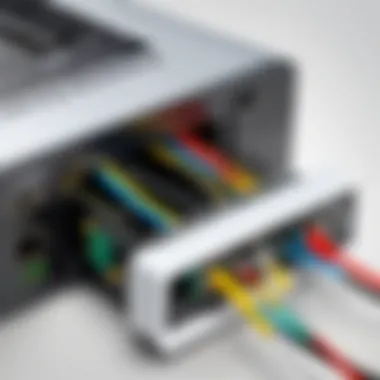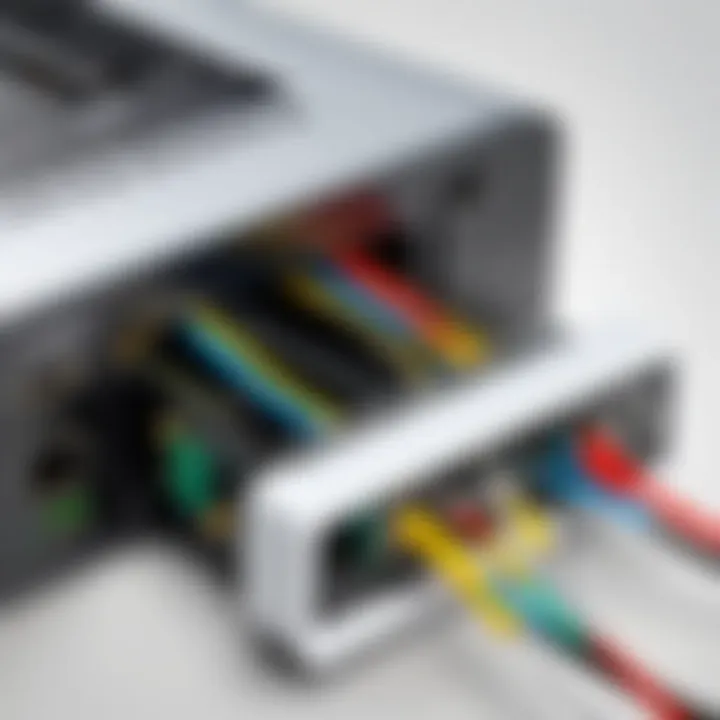Connecting Your Computer to the Internet: A Comprehensive Guide


Intro
Establishing an internet connection is a fundamental aspect of modern computing. For both IT professionals and tech enthusiasts, understanding how to effectively connect a computer to the internet is crucial. This guide provides a comprehensive overview of connection types, setup processes, troubleshooting techniques, and security practices. The information is geared toward maximizing connectivity effectiveness, ensuring that readers are well-equipped to navigate various challenges and opportunities in internet access.
Product Overview
In the realm of internet connectivity, several products and technologies play pivotal roles. This overview will highlight some of the key features and technical specifications pertinent to wired and wireless connections.
Key Features
- Wired Connections: Utilizing Ethernet cables, wired connections offer stability and higher speeds. Features often include:
- Wireless Connections: Wi-Fi technologies enable mobility and convenience. Key features include:
- Low Latency: Ideal for gaming and real-time applications.
- Reliability: Less susceptible to interference compared to wireless options.
- Flexibility: Connect multiple devices without the clutter of cables.
- Advanced Protocols: Support for standards like Wi-Fi 6, enhancing speed and efficiency.
Technical Specifications
Different devices and setups come with varying specifications. For instance, specifying the type of cables or the standards used can greatly impact overall performance. Common specifications include:
- Ethernet: Category 5e, Category 6, etc., which dictate speed and bandwidth capabilities.
- Wireless Standards: 802.11n, 802.11ac, and 802.11ax, which affect range and speed.
"A solid understanding of the specifications aids in selecting suitable equipment for specific needs."
Performance Analysis
To truly grasp the efficiency of these connections, examining their performance becomes necessary. This section will delve into benchmark test results and real-world usage scenarios.
Benchmark Test Results
Testing equipment under controlled conditions offers useful metrics. Factors usually measured include:
- Download and Upload Speeds: Critical for determining performance, these metrics can often vary based on the connection type and distance from the router.
- Latency: Important for applications requiring prompt responses.
Real-World Usage Scenarios
Theoretical values frequently diverge from real-world experiences. Considerations might include:
- Remote Work: Working from home could introduce challenges such as fluctuating speeds and connectivity drops.
- Online Gaming: The choice between wired and wireless could greatly impact performance, especially during peak times.
Understanding Internet Connections
Understanding Internet connections is critical for both IT professionals and tech enthusiasts. The goal of this section is to clarify the different options available for connecting to the internet, each with its unique strengths and weaknesses. Familiarizing oneself with the types of connections can dramatically affect the user experience, performance, and reliability of internet access. Knowing these elements can help users make informed decisions that best suit their needs.
Types of Internet Connections
Fiber Optic
Fiber optic Internet is known for its high speed and reliability. This type employs glass or plastic fibers to transmit data as light signals, allowing for incredibly fast data transfer rates. One major characteristic of fiber optic connections is that they can support up to 1 Gbps or more, making them an excellent choice for demanding tasks like online gaming or streaming high-definition videos.
However, the deployment can be limited in some regions, leading to potential accessibility issues for users. The installation can also be costly, making it less attractive for users who may not need such high speeds.
Cable
Cable Internet utilizes the same infrastructure as cable television, making it widely available in urban and suburban areas. The speed varies based on the service plan chosen, with typical ranges from 10 to 100 Mbps. A key characteristic is sharing bandwidth with other users in the same neighborhood, which can result in slower speeds during peak usage times. While it is often cheaper and more accessible than fiber optic, the shared nature can lead to inconsistent performance.
DSL
Digital Subscriber Line (DSL) technology operates over telephone lines, providing a more stable connection than dial-up. Commonly, speeds tend to range from 1 to 100 Mbps, depending on the service and distance from the provider's office. A beneficial aspect is that users can talk on the phone simultaneously without disruption. However, speed diminishes with distance; thus, users further away from local DSL facilities will experience lower performance.
Satellite
Satellite Internet connects through satellites orbiting the Earth, which can be advantageous in rural areas where traditional connections are unavailable. With speeds reaching up to 25 Mbps, it can be a viable option. The primary unique feature is its ability to offer service anywhere with a clear view of the sky. However, it comes with high latency and potential interruptions due to weather factors, which can detract from its usability for activities that require real-time feedback.
Dial-up
Dial-up is an older technology that connects to the internet through standard phone lines. Although it is the least expensive option, the speeds are extremely slow, typically around 56 Kbps. It is a viable choice in areas lacking modern infrastructure. The unique characteristic of dial-up connections is that they use phone lines exclusively, which can prevent simultaneous phone calls. While useful in specific scenarios, the limitations make it increasingly obsolete in today's fast-paced digital environment.
Connection Speed Considerations
Bandwidth and Throughput
Bandwidth refers to the maximum capacity of data that can be transmitted over an Internet connection at any given time, while throughput is the actual speed achieved during data transmission. Both factors are crucial when evaluating an Internet service. High bandwidth ensures that multiple devices can access the internet simultaneously without slowing down. But throughput can be affected by network congestion, leading to a gap between the two. For optimal performance, it is essential to analyze both to ensure that service matches usage requirements.
Latency
Latency indicates the time it takes for data to travel from the source to the destination. It is often measured in milliseconds (ms). Lower latency is critical for real-time applications like online gaming or video conferencing, where delays can disrupt the experience. Higher latency can result from various factors, including long-distance connections or overburdened networks. Choosing a connection type that minimizes latency can significantly impact user satisfaction.
Factors Affecting Speed
Various elements can influence overall internet speed, including the connection type, network congestion, and physical obstructions. For instance, fiber optic connections generally outperform DSL or satellite options due to their technology. Likewise, physical distance from the service provider can lead to slower speeds, particularly in DSL services. Additionally, environmental factors such as walls or interference from other devices can impede performance. Users should take these factors into account when selecting an internet service to ensure optimal conditions for their needs.
Setting Up a Wired Internet Connection
Establishing a wired internet connection can provide a stable and reliable network, especially for those who require consistent performance for activities like gaming, streaming, or remote work. This section will cover the essential elements, benefits, and considerations for setting up a wired connection. Opting for a wired setup often leads to faster speeds and less interference compared to wireless alternatives. A reliable wired connection can be critical in environments where multiple users are online simultaneously, as it minimizes the chances of congestion.
Essential Hardware Components
Modem
A modem serves as the gateway between your home network and your Internet Service Provider (ISP). It converts the incoming signal from your ISP into a digital format that your devices can understand. One key characteristic of a modem is its compatibility with your ISP; using the right modem ensures you get the best performance.
A popular choice for many is the Netgear Nighthawk CM1200, which supports DOCSIS 3.1 for faster throughput. The unique feature of a modem like this can handle higher speeds, making it advantageous for future-proofing your home internet setup. However, it can be pricier compared to basic models.
Router
The router distributes the internet connection from your modem to all connected devices. It plays a crucial role in managing network traffic and ensuring that data packets reach their intended destinations. The primary characteristic of a router is its ability to facilitate wired and wireless connections.
For example, the ASUS RT-AX3000 router supports Wi-Fi 6 and offers advanced security features. A router's unique ability to manage numerous connections simultaneously allows multiple users to access the internet without sacrificing performance. However, higher-end routers can come with a steeper price tag.
Ethernet Cables
Ethernet cables are the physical medium through which data travels between your modem, router, and computer. They are known for their reliability and speed compared to wireless connections. One key characteristic is their ability to transmit data without interference, which can lead to better performance.


Using Cat 6 Ethernet cables can support gigabit speeds and are often favored for home networks. Their unique feature is the reduced crosstalk and improved bandwidth, making them ideal for heavy usage. On the downside, they require a physical connection, which might limit mobility within the space.
Connecting the Hardware
Wiring the Modem
Wiring the modem is a straightforward process but vital for ensuring connectivity. This involves connecting the modem to the coaxial or DSL line provided by your ISP. One important characteristic of this wiring is that it must be secure to prevent signal loss. Ensuring a good connection here is foundational for establishing internet access.
A good practice is to have the modem positioned in a central area of your home, reducing the length of the wire necessary and potential degradation. This enhances the overall performance of your connection.
Connecting to the Router
The connection from the modem to the router typically uses an Ethernet cable, allowing a seamless flow of data. This step is critical as it determines how well your devices can access the internet. A key aspect to highlight is ensuring you use the correct ports: the modem should connect to the WAN port on your router, typically labeled accordingly.
Inserting the cable firmly will ensure that the connection is stable, which is beneficial for maintaining a strong signal to various devices in your network.
Networking the Computer
Finally, connecting your computer to the router is the last step in establishing a wired internet connection. This is often done using another Ethernet cable. A significant characteristic of networking the computer this way is that it provides the most stable connection available, minimizing latency and data drop-off.
To network your computer, simply plug the Ethernet cable into any of the LAN ports on the router and the corresponding port on your computer. This direct connection negates many potential issues found in wireless networking, such as signal interference or weak signals.
Configuring Network Settings
IP Address Configuration
Configuring the IP address is essential for your computer to communicate on the internet. This involves either setting a static IP address or allowing the router to assign one automatically via DHCP. A key benefit of DHCP is that it simplifies the setup process, eliminating the need for manual entry.
However, using a static IP can provide better control for specific applications that require consistent addressing. It can also lead to easier troubleshooting, should connectivity issues arise.
DNS Settings
DNS settings determine how your computer resolves domain names into IP addresses. Proper configuration is important for browsing efficiency. Using a default DNS server provided by your ISP is common; however, there are benefits to using public DNS providers like Google or Cloudflare.
High-speed DNS can lead to faster web page loading times. Yet, custom DNS may require initial setup, which could discourage some users accustomed to the default settings.
Network Sharing Options
Network sharing allows multiple devices to access the same internet connection and shared resources such as printers or files. Enabling sharing simplifies tasks in a home or office environment. Understanding network sharing options enhances collaborative efficiency.
However, it requires proper configuration of permissions to ensure security. Incorrect setups might lead to unauthorized access, which could jeopardize sensitive information.
Proper setup is vital for a successful wired connection, directly impacting internet performance and security.
Establishing a Wireless Internet Connection
Establishing a wireless internet connection is vital in today's digital landscape. It allows users to connect multiple devices to the internet without the constraints of wires. This flexibility enhances usability in homes, offices, and public spaces, serving various functions from casual browsing to complex online tasks. Understanding the elements involved can improve user experience and efficiency.
Necessary Equipment for Wi-Fi
Wireless Router
A wireless router serves as the backbone of any Wi-Fi network. It connects to the internet service provider via a modem and transmits signals throughout the area, allowing devices to connect wirelessly. The key characteristic of a wireless router is its ability to offer network access to various devices simultaneously. This is intrumental for homes with multiple users.
Many routers also come with advanced features such as dual-band capabilities, improving the speed and reliability of the connection. However, a poorly placed router can lead to dead zones, decreasing effectiveness in some areas.
Wi-Fi Adapter
A Wi-Fi adapter is crucial for devices that do not have built-in wireless capabilities. This small device connects directly to the computer or device, enabling wireless access. The primary characteristic of a Wi-Fi adapter is its versatility, as it can work with various operating systems and devices. Different adapters support various frequencies and speeds, making it essential to select one that meets specific user needs. A potential disadvantage might be the performance limitations on older adapters, which could hinder overall speed.
Repeater/Extender
Repeaters or extenders are devices that amplify the existing wireless signal. They are particularly useful in larger spaces where the router's range may not suffice. The main feature of these devices is their ability to eliminate dead zones, providing additional coverage. This is beneficial in ensuring a consistent connection throughout the area. Nonetheless, they can sometimes only provide a fraction of the original signal's speed, leading to possible performance drops in certain scenarios.
Configuring Wi-Fi Settings
SSID Configuration
Configuring the SSID, or Service Set Identifier, is essential for identifying your wireless network. This unique name allows users to easily recognize and connect to their specific network. The benefit of customizing an SSID is that it can enhance security by avoiding common default names, making it less likely for intruders to guess. However, a unique SSID may not be necessary if strong security protocols are in place.
Security Protocols
Implementing strong security protocols is fundamental in protecting your wireless connection. Standards like WPA3 improve encryption and secure connections against potential breaches. Using these protocols helps safeguard personal and sensitive information during online activities. However, some older devices may not support WPA3, forcing users to choose slightly less secure options.
Channel Selection
Choosing the right channel is another critical aspect of configuring Wi-Fi settings. Wireless networks operate on different channels, and selecting a less crowded one can significantly enhance performance. This aspect directly contributes to reducing interference from nearby networks, especially in densely populated areas. The downside is that manual selection can require a bit of technical knowledge to identify the optimal channel.
Connecting to a Wireless Network
Joining a Network
Joining a wireless network is the initial step in gaining internet access. This process typically involves selecting the desired SSID from the available options and inputting the security password. The ease of this process contributes significantly to the user experience, especially for those connecting multiple devices. However, forgetting passwords can complicate access, necessitating a reset.
Troubleshooting Connection Issues
Troubleshooting connectivity issues is often necessary when experiencing disconnection or slow speeds. Common tactics include restarting the router and checking for obstructions affecting the signal. The ability to quickly resolve these issues is crucial for maintaining productivity. The downside is that not all problems are easily diagnosed, leading some users to seek professional help.
Managing Multiple Connections
In a modern home or office, managing multiple connections can be a daily requirement. This involves prioritizing bandwidth for certain devices or applications, which can be essential for tasks like video conferencing or streaming. The ability to manage these connections effectively enhances network performance. However, mismanagement can lead to frustration and reduced internet speed across devices.
Troubleshooting Connectivity Issues
In the realm of Internet connectivity, troubleshooting is a critical skill that every user should possess. This section examines how to identify and resolve common problems that may affect connectivity, whether it's a sudden disconnection, erratic speeds, or conflicts within the network. Understanding how to tackle these issues enhances both productivity and user experience. Effective troubleshooting not only saves time but also reduces frustration, making it essential for IT professionals and tech enthusiasts alike.
Identifying Common Problems
Identifying issues early can prevent a minor problem from escalating into a major failure. This section covers three prevalent connectivity issues: connection drops, slow speeds, and IP conflicts.
Connection Drops
Connection drops can frustrate users. They occur when a device loses connectivity temporarily, interrupting tasks. A key characteristic of this issue is its inconsistency; it might happen sporadically or at specific times. Understanding this pattern is important, as it can help pinpoint the root cause.
Connection drops are significant in this article because they often indicate underlying issues with network configuration or hardware. The unique feature of this problem lies in the difficulty to diagnose, as it may not appear when testing the connection.
Advantages:


- Quick identification of hardware failure.
- Immediate troubleshooting steps can often restore connectivity.
Disadvantages:
- May be challenging to reproduce, complicating diagnosis.
- Can lead to user distrust of the connection quality if frequent.
Slow Speeds
Slow internet speeds can severely hinder productivity. Unlike connection drops, where the device may lose connectivity altogether, slow speeds manifest as extended loading times and buffering. A key characteristic of slow speeds is their gradual onset, making them difficult to notice at first.
This issue is relevant here because it affects user satisfaction and the efficiency of tasks. The unique feature of slow speeds is that they can derive from various sources—network congestion, insufficient bandwidth, or even issues with the service provider.
Advantages:
- Easily quantified through speed tests.
- Users can learn to optimize bandwidth usage.
Disadvantages:
- Often requires multiple tests to diagnose accurately.
- Solutions can be complex, depending on the source.
IP Conflicts
IP conflicts occur when two devices on the same network are assigned the same IP address. This situation leads to connectivity issues, as the devices will struggle to communicate correctly. The key characteristic of IP conflicts is that they frequently arise in networks with static IP addresses or when devices are connected and disconnected rapidly.
For the purpose of this guide, understanding IP conflicts is beneficial since they hinder network performance drastically. The unique feature of this issue is its potential to cause widespread disruption on a network, affecting all connected devices.
Advantages:
- Clear diagnostic indicators, such as error messages.
- Resolution typically straightforward, often requiring a simple reset of IP assignments.
Disadvantages:
- Can lead to confusion in larger networks.
- Might necessitate an understanding of DHCP settings for resolution.
Diagnostic Tools and Techniques
Once the problem is identified, appropriate diagnostic tools are necessary for effective troubleshooting. This section discusses some essential tools: Ping and traceroute, network scanners, and log analysis.
Ping and Traceroute
Ping and traceroute are fundamental network diagnostic tools. Ping checks the reachability of a device on the network, while traceroute maps the path data takes to reach a specific location. These tools contribute significantly to problem diagnosis by revealing latency and connectivity issues.
A standout feature of Ping and traceroute is their simplicity. They are readily available in most operating systems, making them a common choice. However, while they provide valuable information, they can’t provide insights into all aspects of connectivity.
Advantages:
- Quick and efficient for basic connectivity testing.
- Allows users to identify resulting latency issues.
Disadvantages:
- Limited by the presence of firewalls, which can block tests.
- Cannot diagnose hardware failures.
Network Scanners
Network scanners are applications that identify all devices on a network. They discover IP addresses, open ports, and connected devices. The main advantage of using a network scanner is its ability to give a comprehensive overview of the network, highlighting any anomalous devices.
This feature is instrumental for IT professionals, enabling them to monitor networks effectively. However, overreliance on scanners can lead to negligence in personal monitoring efforts.
Advantages:
- Detailed visibility into network structure.
- Helps locate unauthorized devices quickly.
Disadvantages:
- Requires administrative rights, which might not be available in all environments.
- Potential for false positives if not used carefully.
Log Analysis
Log analysis involves reviewing system and server logs to identify errors and trends. This method is crucial for understanding persistent connectivity issues. The ability to look back at historical data is an advantage, providing context to sporadic issues.
Log analysis is a beneficial choice for this article as it helps uncover problems that may not be immediately obvious. However, it can be time-consuming and often requires specialized skills to interpret accurately.
Advantages:
- Provides detailed insights into network behavior.
- Useful for detecting patterns related to connectivity issues.
Disadvantages:
- Can be daunting for those not familiar with technical jargon.
- Requires careful management and storage of log files to avoid missing data.
Solutions for Common Issues
Once problems are identified, effective resolutions need to be implemented. This section provides solutions for restarting equipment, updating drivers and firmware, and reconfiguring network settings.
Resetting Equipment
Resetting equipment is often the first recommended solution for many connectivity issues. This process involves power cycling devices such as modems, routers, and even personal computers. The key characteristic is its simplicity and speed.
This is an accessible solution for most users, making it a popular recommendation in troubleshooting guides. It allows devices to clear their memory and re-establish connections efficiently, resolving many transient issues.
Advantages:
- Quick fix for many common problems.
- Usually requires little technical knowledge from the user.
Disadvantages:
- Temporary solution, requiring further investigation for recurring problems.
- May disrupt network activity temporarily.
Updating Drivers and Firmware
Updating drivers and firmware is a more involved solution but essential for maintaining optimal connectivity. Outdated software can lead to compatibility issues and instability. The key characteristic here is that keeping these updated is often overlooked.
This choice is beneficial for ensuring security and functionality, allowing devices to operate smoothly. However, it can be time-consuming and may require a level of technical knowledge.
Advantages:


- Ensures devices function with the latest improvements and security patches.
- Can resolve persistent issues related to incompatibility.
Disadvantages:
- Error during updates can cause additional issues.
- Requires planning and scheduling to avoid service disruption.
Reconfiguring Network Settings
Reconfiguring network settings often becomes necessary when previous configurations lead to conflict or connectivity issues. This can entail changing IP settings, DNS configurations, or even altering wireless security settings. This aspect is critical as it often requires some understanding of networking principles.
It offers a deeper dive into optimizing network performance, making it beneficial for this article. The unique feature is that it empowers users to tailor their networks according to specific needs and conditions, leading to potentially improved performance.
Advantages:
- Customization to user requirements can enhance performance significantly.
- Can resolve conflicts and optimize network flow.
Disadvantages:
- Possibility of misconfiguration, leading to further issues.
- Might require advanced understanding of the networking environment.
Security Considerations for Internet Connections
In today's digital landscape, securing your internet connection is paramount. As more devices connect online, the risk of unauthorized access and data breaches increases. Ensuring that your network is well-protected can safeguard personal information, sensitive data, and the integrity of your systems. Key aspects include wired security measures, wireless protocols, and methods to prevent unauthorized access. This section explores these areas and highlights why security is essential in establishing a reliable internet connection.
Securing Wired Connections
Physical Security Measures
Physical security measures are fundamental in protecting wired connections. This aspect ensures that only authorized personnel have access to the network hardware. Moreover, locked server rooms or dedicated spaces help in preventing physical tampering. The key characteristic of this measure is the direct control over physical access to your equipment. In practice, using secure locations for routers and switches is a widely favored option in professional settings. However, one disadvantage is that it can require significant investment in infrastructure.
Access Control Lists
Access Control Lists (ACLs) are essential for defining who can access what within a network. This characteristic allows for precise management of user permissions, enhancing security by limiting access to sensitive resources. ACLs are popular because they provide a clear framework for user rights management and monitoring. The unique feature of ACLs is that they can be configured on routers and switches. This means they apply at various points in the network. However, improper configuration can lead to insufficient security and unintentional denials of service for authorized users.
Network Monitoring
Network monitoring is vital for detecting unauthorized activity within wired connections. Continuous monitoring allows for the identification of unusual patterns that may indicate security breaches. The key characteristic of network monitoring is its proactive approach to security. It enables IT professionals to respond swiftly to threats. A unique feature of this method is its ability to provide real-time alerts and logs for future analysis. On the downside, monitoring can require substantial resources and expertise to implement effectively.
Enhancing Wireless Security
Changing Default Credentials
Changing default credentials is one of the simplest yet most effective ways to enhance wireless security. Most network devices come with preset usernames and passwords, making them easy targets for hackers. The key characteristic here is that customized settings significantly lower the risk of unauthorized access. This practice is beneficial because it requires minimal technical skills. One potential disadvantage is that users may forget their new credentials unless they are well-documented.
Implementing WPA3
WPA3 is the latest security protocol for securing wireless networks. It provides enhanced protection against brute-force attacks by employing stronger encryption methods. The key characteristic of WPA3 is its improved security features, making it a popular choice for modern networks. A unique feature includes its ability to strengthen encryption even when the password is weak. However, many older devices may not support WPA3, limiting compatibility and forcing users to consider hardware upgrades.
Guest Network Configuration
Configuring a guest network allows visitors to access the internet without exposing the primary network. This design is increasingly popular as it separates sensitive data from lesser-trusted devices. The unique characteristic of this setup is the added layer of security for the main network. It is beneficial for both businesses and homes. However, managing multiple networks does add complexity to setup and maintenance.
Preventing Unauthorized Access
Firewall Setup
A firewall setup is crucial in creating a secure perimeter for the network. Firewalls monitor and control incoming and outgoing network traffic based on predetermined security rules. The key characteristic of a firewall is its ability to block potentially harmful traffic. This makes it a cornerstone of modern security practices. While the benefits are significant, there is a downside: improperly configured firewalls may impede legitimate traffic, causing frustration for users.
VPN Configuration
Virtual Private Networks, or VPNs, enhance security by encrypting internet traffic and masking the user's IP address. This adds strong privacy protections and helps prevent unauthorized data interception. The key characteristic is the encryption process, which is effective in keeping data secure from prying eyes. VPNs are especially beneficial for individuals accessing sensitive information on public networks. However, there can be limitations in speed and potential complications in configuration.
Regular Security Audits
Conducting regular security audits is essential for maintaining effective security protocols. Security audits assess the network for vulnerabilities and compliance with security policies. The key characteristic of these audits is that they provide an objective view of the current security posture. They are a beneficial choice for organizations to ensure ongoing protection. The disadvantage lies in the resources required to perform thorough audits and the possible need for expertise from outside consultants.
The Future of Internet Connectivity
The future of internet connectivity is a crucial topic in understanding how to effectively connect a computer to the internet. This section aims to highlight several key elements such as emerging technologies and trends that influence connectivity choices. As the landscape of internet technology evolves, these advancements will shape both personal and professional online experiences.
Emerging Technologies
5G Implementation
5G technology stands at the forefront of modern connectivity solutions. Its significance lies in its ability to provide faster speeds, increased capacity, and lower latency compared to previous generations. This is crucial for applications demanding high-speed data transmission, such as online gaming and streaming services. The key characteristic of 5G is its use of higher frequency bands, which allows for much more data to flow simultaneously, enhancing overall network performance.
However, the rollout of 5G also comes with disadvantages, including limited availability in certain regions. As infrastructure continues to be developed, achieving widespread access is essential to fulfill its potential.
Satellite Internet Advancements
Satellite internet has seen remarkable advancements, addressing issues of connectivity in remote areas where traditional internet services may not reach. The ability to connect computers to the internet from virtually any location is a significant feature. Modern satellite systems have decreased latency and increased bandwidth compared to the early versions of this technology.
This makes satellite internet an appealing choice for individuals and businesses in underserved areas. Despite its advantages, challenges persist, such as weather-related disruptions and potential service limitations.
Mesh Networking Solutions
Mesh networking presents a dynamic alternative to traditional router setups. In essence, it allows multiple devices, called nodes, to work together to create a seamless network. This helps extend coverage areas and improve connectivity within homes or large spaces. The key benefit of mesh networks is their ability to eliminate dead zones, providing consistent internet access.
Mesh networks are becoming increasingly favorable as smart home devices proliferate. Still, they may incur higher setup costs and be more complex to manage, posing considerations for users looking to implement such a solution.
Trends Impacting Connection Choices
Remote Work Influence
The recent shift to remote work has had a profound impact on internet connectivity. More individuals are relying on stable internet connections to perform their jobs effectively. The growing need for uninterrupted access to online resources makes it crucial for organizations to invest in robust connectivity solutions. This trend is reshaping decisions regarding how connections are facilitated, often prioritizing speed and reliability over cost.
However, the shift to remote work comes with challenges for employees, including reliance on one’s home internet, which may not always match the quality of corporate environments.
Smart Home Integration
The integration of smart home devices into everyday life has created new demands for internet connectivity. Many households now utilize multiple devices that require a constant internet connection, including smart thermostats, lighting, and security systems. The key characteristic here is the necessity for efficient bandwidth management within the home network.
While this is beneficial as it promotes convenience and energy saving, the added load on home networks can lead to reduced performance. Therefore, it is essential for users to consider their internet options seriously, especially as more devices become connected.
Data Privacy Concerns
With increased connectivity comes heightened concerns over data privacy. As internet use expands, so does the risk of data breaches and unauthorized access. Understanding privacy implications is vital for users. This growing awareness is prompting individuals and organizations alike to take extra measures in securing their networks against potential threats. Privacy concerns further influence how people choose their internet providers and what technology they employ.
"Prioritizing connectivity while ensuring data privacy is not just a choice; it has become a necessity in our digital era."
To sum up, the future of internet connectivity hinges on evolving technologies and shifting trends. These new advancements offer endless possibilities, enriching user experiences but also bringing about challenges that must be addressed.



